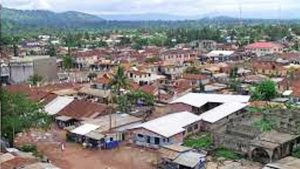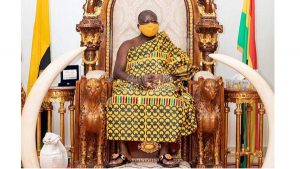In the Akan societies of West Africa, names and the process of naming are essential since everyone and almost every living entity has a place and mission in the world. The name of a person or entity reflects its purpose in life.
The adinto or abadinto (lit., “to throw [a] name”) or naming ceremony takes places usually at the father’s house on the eighth day, that is, a week after and on the day the child was born. For example, a child born on Sunday will have his or her naming ceremony on the following Sunday and will be given the first name, Kwasi or Akosua. For the Akan, a child’s first name or kradin (“soul name”) is routinely given based on the Akan week (nnawɔtwe, “eight days”).
The following shows the Akan naming system according to the days of the week:
Days: Sunday, Monday, Tuesday, Wednesday, Thursday, Friday, and Saturday
Male names: Kwasi/Kwesi, Kwadwo, Kwabena, Kwaku, Kwao/Yaw, Kwafi/Kofi, and Kwame/Kwamena
Female names: Akosua/Esi, Adwoa, Abena, Akua, Yaa, Afia/Afua, and Amma
Praise names: Bodua (protector, leader), Okoto (calm, humble), Ogyam (good, humane), Ntonni (advocate, hero), Pereko (fearless, firm), Okyin (adventurer, itinerant), and Atoapem (ancient, heroic)
The purpose of waiting seven days after the birth of a child is to ensure that he or she has come to stay on earth (Asase Yaa) and will not prematurely return to Asamando (“abode of the ancestors”). Until that day, the child is regarded as a “stranger” (ɔhɔho). Thus, the Akan say to the new infant child, woaba a tena aseɛ (“now that you have come, sit down or do stay”); this phrase is a greeting that is said to an infant to wish the child long life.
The general procedure for the ceremony is as outlined.
Before the scheduled day of the ceremony, items such as gin (nsa), two glass cups (nkuruwa), a bottle of water (nsuo), a mat (kɛtɛ), a calabash (pakyi or kora), and a broom (ɔprae) for young women and a cutlass (nkrante) for boys are gathered.
Early in the morning of the scheduled day, two elders (mpanyimfoɔ) of good character from the father’s family are sent to go and bring the child and mother from the mother’s house. One elder is chosen to perform the ceremony; if it is a male child, that person chosen will be a man and conversely.
The mother bathes the infant and they both dress in white cloth and stay indoors until the ceremony begins. Certain sacred beads (such as bɔdɔm, ahenewa, and abobɔe) are put on the child, and marks made with white clay (hyire) and specific to this ceremony are put on the child.The purpose of smearing the white clay on the skin of the baby is to making the baby gain weight quickly and also to be a useful emollient ie. It gives a soothing effect to the skin, it also makes the skin smooth and shiny by treating acnes and other skin rash. As early as 5 to 6 a.m, close relatives and friends of the mother help in the preparation.
The ceremony starts with an opening libation (mpaeɛ) poured by an elder who announces the occasion and the purpose of it. The mother’s family provides the drink used for this libation, which is poured at every doorstep and the main entrance to the house. The father’s family provides the drink for the second libation. After this libation, the child is brought out and stripped naked. The child is then placed on a prepared area of the ground or on a comfortable cushion.
Around 7 a.m., when all guest have arrived, a female or male elder of the father takes the child to her or his lap and both the water and the gin is poured into separate glasses. Naming the child is the responsibility of the father’s family. The father’s female or male elder then dips her or his forefinger into the gin or uses a leaf and then drops it on the child’s tongue and says, “when we say that it is gin (symbolic of untruth), say that it is gin” (sɛ yɛka se nsa a ka se nsa) three times.
The elder does the same with the water: “when we say that it is water (symbolic of truth), say that it is water” (sɛ yɛka se nsuo a ka se nsuo). Both of these tastings advise the child to seek and tell the truth and to distinguish it from falsehood as she or he tries to live a righteous and ethical life.The child’s name is given by the father (agya) and the child is then given a name: we will call you ____ and this name means _________ (yɛbɛfrɛ wo ______ ne asekyerɛ din yɛ ______). From today onward, we will call you _____ (ɛfiri nne rekɔ yɛbɛfrɛ wo _____).
The second name of the child can come from consulting an ɔkɔmfoɔ (spiritualist/healer) or ɔbosomfoɔ (spiritualist/healer), an elder or ancestor of the father’s family of good character, circumstances of the child’s birth, and the like. As such, the second name is properly called agyadin (name from the father), which was synonymous with a family name or surname. Most Akan had two names—their “soul” name and the name from their father at birth—before the arrival of the Christian orthodoxy in present‐day Ghana. Today, many Akan people have a first, middle, and last name or surname.
A mat is spread on the floor and the child is lifted three times, placed on the mat naked, and the broom is put in her hand and she is covered with the calabash; after a second or so, the calabash is removed.
This process symbolizes the ethic of hard work, preserving a household and family, and working complementarily with her husband once married. If the child is a boy, a cutlass is placed by his side (hand); the cutlass symbolizes a similar work ethic, providing for and protecting his family, and working complementarily with his wife once married. And the child been placed on a mat also symbolize thanksgiving to Asase Yaa (Mother Earth) for sustaining its life and to the ancestors for their eternal protection and guidance.
The child is then presented to the community; this is called “outdooring” because it is the first time the child is taken out of the house. A final libation is poured to consecrate the ceremony, and blessings for the child and his or her family is requested along requests for the child to be an obedient, truthful, and righteous member of the community. Next, the child is addressed by their name and told what family and community members expect of him or her. Songs of praise are sung to the child. Those in audience bring the child gifts (such as money [sika] or clothing [ntadeɛ]), and feasting with singing and dancing begins. The ceremony officially ends.
“Konti ne Akwamu, Adonten, Gyaase, Kyidom, Adehyeman mma, mese mo aburu. Mpanyin se, “sɛ w’anto wo fie badin a, woyera wo mpanyinsem” I hope you have learnt something today???. Biom mase mo sɛ, “Tete bɛka ason no, na efi teka kyerɛ”. Let us endeavour to give our children teachings of our history and traditions which will bring us closer to our lineage and culture, and to up hold the dignity of our forebears and beyound.
Source: Ashantibiz
Submit your stories or articles to us via WhatsApp +233-245092915




